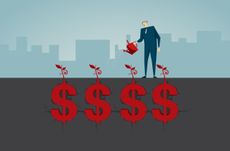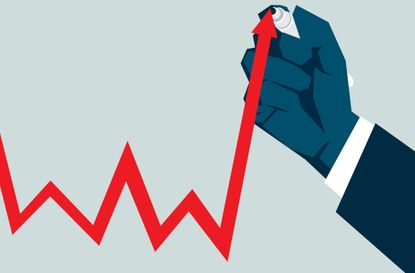Economic Forecasts
Kiplinger's Economic Outlooks are written by the staff of our weekly Kiplinger Letter and are unavailable elsewhere. Click here for a free issue of The Kiplinger Letter or more information.
Economic Outlooks — Quick Links
Kiplinger's Economic Outlooks are written by the staff of our weekly Kiplinger Letter and are unavailable elsewhere. Click here for a free issue of The Kiplinger Letter or more information.
Read our current forecasts:
- GDP forecast » | Interest rates forecast » | Inflation forecast »
- Energy forecast » | Housing forecast » | Jobs forecast »
- Retail forecast » | Trade forecast » | Business Costs»
Gross Domestic Product Outlook
Read our current GDP forecast »
Gross domestic product is the broadest indicator of the economy, measuring the value of final goods and services produced in the U.S. in a given time period. It is perhaps the most closely watched indicator as well, serving as a guidepost for Federal Reserve interest rate policy and for budgeting in both government and private industry.
At Kiplinger, we examine what trends are driving GDP up (or down) and forecast its future direction quarter by quarter.
Interest Rates
Read our current interest rates forecast »
Interest rates are of tremendous interest to borrowers (for whom they are a cost) and lenders (a category that includes individuals trying to get some return on their bank savings). Almost everyone is in one or both categories. The level of short-term rates, such as those used by banks when loaning each other money overnight, is set by the Federal Reserve through its Open Market Committee, usually at regularly scheduled Fed meetings.
Generally, the longer the period of the loan, such as with 10-year Treasury Bonds or mortgages, the more important market factors become compared with the Federal Reserve's actions. We forecast both what we expect the Federal Reserve to do in the near term and to what extent that will affect the direction of long-term interest rates.
Inflation Rate
Read our current inflation forecast »
Inflation is the generally rising price of goods and services, or why things cost more. It's measured by the Department of Labor using a sample, dubbed a "market basket," of what people in urban areas in the U.S. actually buy each month. Then each month, data collectors check the prices of those items. From that research, we get the Consumer Price Index (CPI). A component of that index, the core inflation rate, which excludes the more volatile prices of food and energy, is also closely watched. At Kiplinger, we forecast changes in both.
Economists generally believe that moderate inflation is best for an economy. Prices that are rising too quickly cause consumers heartburn, of course, but prices that are flat or falling are a problem, too. This condition, known as deflation, makes debts more expensive to pay back and can lead to declining business investment.
Employment Outlook
Read our current jobs forecast »
If gross domestic product is the broadest indicator of the economy, employment is the one most personally felt. These are people's jobs we're talking about.
Two distinct metrics make up the employment forecast. The more important one is the "payroll report," a summation by the Department of Labor of how many jobs the economy has created (or lost) each month. This data is broken out by sector, such as manufacturing, mining and health care. Note that simply to keep up with population growth, the economy needs to add more than 100,000 jobs every month; otherwise the unemployment rate will rise.
That rate is the other closely watched figure. It's a simple division of the number of people who have looked for work in the prior four weeks but who do not have a job by how many people are currently in the labor force. That simplicity belies some underlying concerns about the unemployment rate. One key concern: Potential workers who aren't actively looking for work aren't included in the calculation.
Energy
Read our current energy forecast »
Like it or not, petroleum and natural gas remain incredibly important to the U.S. economy. Knowing where oil prices are headed is critical to businesses of all stripes, from airlines to plumbing companies. Consumers planning their family budgets and their vacations care, too. Not only do we monitor Department of Energy reports, but we also talk to commodities traders and petroleum engineers to forecast price trends, changes in production technologies and consumer habits.
Housing
Read our current housing forecast »
In addition to being the roof over our heads, housing is an important sector in the economy. Three statistics form the core of our coverage: sales of existing homes (and the prices those sales fetch); sales of new homes; and housing starts, which reflect new construction that is counted in GDP.
Because housing is a diversified and highly regional industry, our reporting and forecasting are informed by other research as well as conversations with industry experts as well.
Retail
Read our current retail forecast »
Consumers are the engine of our economy, and when their spending flags, business feels it. We examine trends that are influencing their habits, such as falling gas prices, to forecast what they'll be buying in the future and how much they'll be willing to shell out both on everyday items and on big-ticket purchases such as cars and trucks.
Trade
Read our current trade forecast »
All nations of consequence trade with others. Those that buy more from other countries than they sell in turn have a trade deficit, and that's been the story for the United States since the mid-1970s.
How big that deficit will be, and whether the changes will result from more (or fewer) imports or more (or fewer) exports, is the crux of our forecasting. We look at specific sectors (such as agriculture) where the United States is doing well selling abroad, as well as what items (such as smartphones) we buy from overseas. We also discuss the strength of the dollar versus foreign currencies and how that affects trade trends.
Business Costs
Read our current business costs forecast »
How much businesses are laying out in investment is critical to other businesses in guiding their own spending. In making our forecasts for the direction of business spending in the quarters and years ahead, we follow two indexes from the Census Bureau: Durable Goods Shipments and Orders and Business Inventories reports.
Latest
-

Kiplinger Jobs Outlook: Hiring Continuing at Reduced Levels
Economic Forecasts Kiplinger's monthly jobs round-up covers the latest changes in the labor market, from job gains to wage fluctuations.
By David Payne
Economic Forecasts -

The Kiplinger Letter's 10 Forecasts for 2026
The Kiplinger Letter Here are some of the biggest events and trends in economics, politics and tech that will shape the new year.
By Letter Editors
The Kiplinger Letter -

Kiplinger GDP Outlook: No Recession, But Low Economic Growth
Kiplinger Forecasts In the latest Kiplinger GDP forecast, we expect modest-to-moderate growth in the second half of 2025 and through 2026.
By David Payne
Kiplinger Forecasts -

Special Report: The Future of American Politics
The Kiplinger Letter The Political Trends and Challenges that Will Define the Next Decade
By Matthew Housiaux
The Kiplinger Letter -

Kiplinger Housing Outlook: A Critical Turning Point in 2026
Economic Outlooks The housing market is in the doldrums, but subtle shifts are finally on the way.
By Rodrigo Sermeño
Economic Outlooks -

Exports have held up reasonably well despite tariff disputes
Forecasts Kiplinger's latest forecast on trade: U.S. exports, imports and our net trade deficit.
By Rodrigo Sermeño
Forecasts -

Kiplinger Retail Outlook: Consumer Spending Surprisingly Strong
Economic Forecasts E-commerce sales jumped again in October, but in-store sales benefited, as well.
By David Payne
Economic Forecasts -

Kiplinger Interest Rates Outlook: Cuts Expected to Continue
Forecasts Kiplinger's experts forecast what's happening and what's next for interest rates and the Federal Reserve.
By David Payne
Forecasts -

What to Expect from the Global Economy in 2026
The Kiplinger Letter Economic growth across the globe will be highly uneven, with some major economies accelerating while others hit the brakes.
By Rodrigo Sermeño
The Kiplinger Letter
